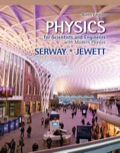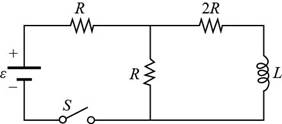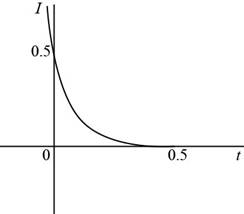
Concept explainers
(a)
The inductor behaves like an open circuit or short circuit or a resister of some particular resistance or none of those choices before the switch is opened.
(a)
Answer to Problem 32.64AP
Explanation of Solution
Given info: The induced voltage is
The inductor has no resistance. If the switch is closed for a long time, then inductor will reach saturation and voltage passes through the inductor. Hence, it behaves as a short circuit.
Conclusion:
Therefore, the inductor behaves as the short circuit because of no resistance.
(b)
The current carried by the inductor.
(b)
Answer to Problem 32.64AP
Explanation of Solution
Given info: The induced voltage is
The figure of the circuit diagrammed referred from P31.15 is shown below.

Figure (1)
The net resistance for parallel combination is,
Here,
The net resistance is connected in series with
Here,
Substitute
Substitute
Formula to calculate the current of battery is,
Here,
Substitute
The voltage across the parallel combination of resistors is,
Substitute
Formula to calculate the current though the inductor is,
Substitute
Conclusion:
Therefore, the current carried by the inductor for
(c)
The energy stored in the inductor.
(c)
Answer to Problem 32.64AP
Explanation of Solution
Given info: The induced voltage is
Formula to calculate the energy stored in the inductor is,
Substitute
Thus, the energy stored in the inductor for
Conclusion:
Therefore, the energy stored in the inductor for
(d)
The energy previously stored in the inductor after the switch is opened.
(d)
Answer to Problem 32.64AP
Explanation of Solution
Given info: The induced voltage is
When switch is opened, the energy stored in the inductor will dissipate through resistor
Conclusion:
Therefore, the energy becomes
(e)
To draw: The graph of the current in the inductor for
(e)
Answer to Problem 32.64AP
Answer The graph of the current in the inductor for

Explanation of Solution
Introduction:
The graph of the current verses time shows the variation of the current in the circuit with time and tells the nature of the current.
Explanation:
Given info: The induced voltage is
After time
Formula to calculate the time constant is,
Substitute
Substitute
The current flowing through the inductor at time
Substitute
Thus, the graph of the current (the initial and final values) in the inductor for

Figure (2)
The graph shows that current decays with exponentially with time constant. The current decreases from
Want to see more full solutions like this?
Chapter 32 Solutions
EBK PHYSICS FOR SCIENTISTS AND ENGINEER
- pls help on all asked questions kindlyarrow_forward19. Mount Everest, Earth's highest mountain above sea level, has a peak of 8849 m above sea level. Assume that sea level defines the height of Earth's surface. (re = 6.38 × 106 m, ME = 5.98 × 1024 kg, G = 6.67 × 10 -11 Nm²/kg²) a. Calculate the strength of Earth's gravitational field at a point at the peak of Mount Everest. b. What is the ratio of the strength of Earth's gravitational field at a point 644416m below the surface of the Earth to a point at the top of Mount Everest? C. A tourist watching the sunrise on top of Mount Everest observes a satellite orbiting Earth at an altitude 3580 km above his position. Determine the speed of the satellite.arrow_forwardpls help on allarrow_forward
- pls help on allarrow_forward6. As the distance between two charges decreases, the magnitude of the electric potential energy of the two-charge system: a) Always increases b) Always decreases c) Increases if the charges have the same sign, decreases if they have the opposite signs d) Increases if the charges have the opposite sign, decreases if they have the same sign 7. To analyze the motion of an elastic collision between two charged particles we use conservation of & a) Energy, Velocity b) Momentum, Force c) Mass, Momentum d) Energy, Momentum e) Kinetic Energy, Potential Energyarrow_forwardpls help on all asked questions kindlyarrow_forward
- pls help on all asked questions kindlyarrow_forward17. Two charges, one of charge +2.5 × 10-5 C and the other of charge +3.7 × 10-6 C, are 25.0 cm apart. The +2.5 × 10−5 C charge is to the left of the +3.7 × 10−6 C charge. a. Draw a diagram showing the point charges and label a point Y that is 20.0 cm to the left of the +3.7 × 10-6 C charge, on the line connecting the charges. (Field lines do not need to be drawn.) b. Calculate the net electric field at point Y.arrow_forward3arrow_forward
 Physics for Scientists and Engineers, Technology ...PhysicsISBN:9781305116399Author:Raymond A. Serway, John W. JewettPublisher:Cengage Learning
Physics for Scientists and Engineers, Technology ...PhysicsISBN:9781305116399Author:Raymond A. Serway, John W. JewettPublisher:Cengage Learning Principles of Physics: A Calculus-Based TextPhysicsISBN:9781133104261Author:Raymond A. Serway, John W. JewettPublisher:Cengage Learning
Principles of Physics: A Calculus-Based TextPhysicsISBN:9781133104261Author:Raymond A. Serway, John W. JewettPublisher:Cengage Learning Physics for Scientists and EngineersPhysicsISBN:9781337553278Author:Raymond A. Serway, John W. JewettPublisher:Cengage Learning
Physics for Scientists and EngineersPhysicsISBN:9781337553278Author:Raymond A. Serway, John W. JewettPublisher:Cengage Learning Physics for Scientists and Engineers with Modern ...PhysicsISBN:9781337553292Author:Raymond A. Serway, John W. JewettPublisher:Cengage Learning
Physics for Scientists and Engineers with Modern ...PhysicsISBN:9781337553292Author:Raymond A. Serway, John W. JewettPublisher:Cengage Learning Physics for Scientists and Engineers: Foundations...PhysicsISBN:9781133939146Author:Katz, Debora M.Publisher:Cengage Learning
Physics for Scientists and Engineers: Foundations...PhysicsISBN:9781133939146Author:Katz, Debora M.Publisher:Cengage Learning College PhysicsPhysicsISBN:9781285737027Author:Raymond A. Serway, Chris VuillePublisher:Cengage Learning
College PhysicsPhysicsISBN:9781285737027Author:Raymond A. Serway, Chris VuillePublisher:Cengage Learning





